

# of episodes
episode average
26
3.08
series Top 20
series Flop 20
2 episodes
1 episodes
SEASON BEST
The Inner Light
Darmok
The First Duty
Unification (I-II)
Ensign Ro
SEASON WORST
Imaginary Friend
The Game
The Perfect Mate
The Masterpiece Society
Violations
4.26/5.1 REDEMPTION (I-II)
Gowron's succession bid results in Klingon civil war.



WORTH WATCHING
The Klingon succession disputes reach its peak in this formulaic but entertaining action two-parter. Besides Gowron’s leadership bid, the episode introduces several subplots and characters that will continue to be relevant later in TNG. Most important is Sela of course. Viewers who haven’t seen the show’s first season, and also S3’s “Yesterday’s Enterprise,” may struggle to grasp the size of her reveal at the end of part one, but it is truly momentous and (if possible) an even bigger “wtf?!” moment than Picard’s assimilation as Locutus. Even better, Sela is more than a cardboard villain and the first, perhaps the only, three-dimensional Romulan on the show. The Klingon sisters Lursa and B’Etor are also introduced here, though their future role is far less relevant. But once more, Worf carries the weight of this episode on his shoulders, especially in his rapport with Picard. Their conversations on duty, honor, and allegiance take on a new spin as Worf temporarily resigns his Starfleet commission. Even though Picard himself has little at stake here, his role is well written as a foil to Worf, the anchor to his Federation membership. Indeed, there is little to do for humans in this story at all: Riker and La Forge have minor roles, and Troi and Crusher don’t even have a single line of dialogue. Only Data remains relevant, thanks to the USS Sutherland side plot, which while irrelevant to the story it advances his personal development interestingly (and will be the source of future sparring between him and Sela when they do meet at last). On its own merits, this is a weaker episode than S3’s “Sins of the Father” and S4’s “Reunion,” but it carries the torch well enough to provide a satisfactory conclusion to the succession chapter of the Klingon political intrigue. And while Worf’s story is far from over, there would be no more major Klingon political affairs until DS9’s Dominion War causes major allegiance shifts across the quadrant.
Picard is stranded with an alien who communicates in obscure metaphors.
5.2 DARMOK
I consider this TNG's second-best standalone (after “The Inner Light”) and among the best episodes of the entire franchise, for it is a literary classic well outside the realm of Star Trek and of science-fiction as a whole; that is, it is founded on timeless narrative archetypes that even casual viewers will be able to appreciate without subscribing to TNG's overall premise. As in the best classics, the episode’s starting point is very simple: two people stranded on dangerous terrain must learn to communicate, or perish. The result is a simple and elegant drama that ranges broadly as well as reaches deeply. The script successfully makes two main arguments: that communication shapes one’s very way of thinking, and consequently one’s worldview; and that what we call “Otherness” is but a result of poor communicative imagination. It makes these two points by casting not Picard, but an alien captain as the hero, the Enkidu to Picard’s Gilgamesh. It is his conviction that drives the entire exchange, and his relentless desire for intercultural rapport that motivates Picard’s own. After all, one would imagine that the Children of Tama would have realized long ago that their language is unique in their region of the galaxy, which would force them to seek such relatively extreme methods to build bridges. In this way, through Dathon (as well as his first officer on the ship) we gain useful insight into Tamarian society. The best part is that the exchanges between Riker and Dathon’s first officer in space serve as a valid foil to those between Picard and Dathon on the planet: they represent what would happen in a regular first contact situation had Dathon not dared as he did. And while the conclusion is predictable, it is so only in the way that it follows the standard archetypal structure of these narratives: the hero’s self-immolation allows his friend and follower to complete his mission, represented by Picard’s fluent conversation with Dathon’s first officer once he returns to the Enterprise. This scene also reminds us how delightfully simple communication is: we have learned but 4-5 phrases in the Tamarian language, and yet they are sufficient to carry out a nuanced and substantive dialogue among equals.



SERIES TOP 20
5.3 ENSIGN RO
Picard and a disgraced officer negotiate with Bajoran terrorists.
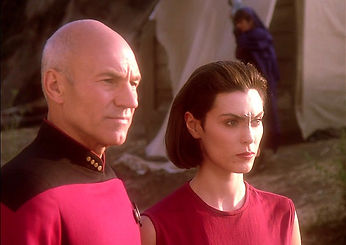

SEASON TOP 5
This episode marks the introduction of the charismatic Ro Laren, as well as of the Bajoran-Cardassian relations that will drive most of the main plot arcs in DS9. This was clearly a way to introduce audiences to these themes, as DS9 was just entering production during TNG’s fifth season. The creation of Ro was so successful, thanks in no small part to Michelle Forbes’s nuanced and powerful portrayal, that she’d go on to become one of the show’s most frequent recurring characters, even having a few episodes of her own. As for this episode, it is a fairly standard thriller with a predictable twist, but it should be taken first and foremost as an introduction to Bajoran-Cardassian politics. In a way, it rectifies some of the downsides of the poorly-received S3’s "The High Ground," which failed to sufficiently analyze the moral reasons that push a desperate people to "terrorism." And while certainly DS9 as a whole would do a much more thorough job of it, this episode lays out the groundwork for many of those later episodes (as well as some of the Maquis plot arcs later in DS9’s run). All conversations between Ro and Picard are interesting and go far below the surface, as are the ones with Guinan, who finally returns to TNG after a too-long hiatus. So despite lacking some originality, especially with regard to the villains, the episode works remarkably well and delivers in troves.
The crew hunt down the Crystalline Entity after a series of attacks.
5.4 SILICON AVATAR
It didn’t seem possible to write another interesting chapter to Data’s family backstory; surely enough, the eventual reintroduction of Lore in S6’s "Descent" is rather unsuccessful. But this episode succeeds in finally giving a purpose to the Crystalline Entity, which until now had been (to be frank) a little ridiculous. Here it becomes a foe worthy of consideration, thanks to the emotional scenes in the teaser. But it is Kila Marr who steals the show. Played powerfully by Ellen Geer, her character is extremely effective despite being a tad unoriginal. Even though audiences know early on that something’s not right, and that Marr’s distrust of Data surely must hide a deeper secret, the eventual personal drama is shocking as it is well written. Especially the ending, though again somewhat predictable, works remarkably well. Spiner is particularly good (as usual) at portraying an emotionless character in a typically emotional role; the final blow that he deals to Marr, with the revelation that her son would not be proud of her, is as painful as it is well scripted. So while the episode doesn’t rank among the season’s best, it is surely worth watching, even only for the Data-Marr rapport.

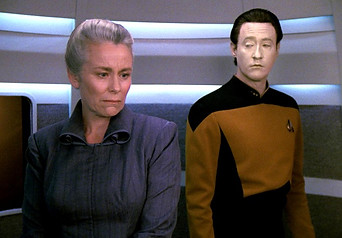
WATCH FOR CONTINUITY
5.5 DISASTER
A collision with a quantum filament wreaks havoc on the Enterprise.
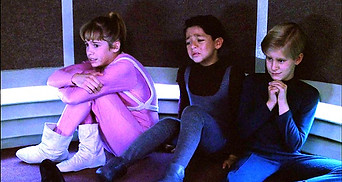

SKIPPABLE
An average disaster tale that could have been a lot more exciting, and which instead opts for some trite scenarios and a decidedly lackluster conclusion. As usual, the premise is sound: the Enterprise is severely damaged and the crew must struggle to survive. But this seemingly exciting scenario actually yields some sub-par action. The problem, as usual, is in the planning. The crew is split five-fold in slightly related scenarios, none of which work very well. There is a huge engineering problem, but the engineer is stuck in a cargo bay with the doctor. There is a command problem, but the captain is stuck in the turbolift with (oh. my. god) three whiny children. And there is a baby coming, and Keiko is stuck with... Worf. But instead of presenting challenges to overcome, these scenarios quickly degenerate into caricatures, where the characters (and therefore the audience) have to work extra hard to achieve relatively simple tasks. The result is far from rewarding, and it ends dragging what should have been a fun technobabble-filled romp.
An addictive game brainwashes the crew to obey an alien captain.
5.6 THE GAME
An original and potentially entertaining premise -- a game so addictive that it effectively rewires the brain to accept subliminal orders -- which suffers from a shoddy execution full of plot holes. It truly stretches the imagination to think that the Enterprise could be conquered quite so easily, or that literally one thousand people would buy into a fad in a matter of hours. These problems are compounded by the much too common awkward role for a returning Wesley Crusher; and if that was not enough, he is paired with a young Ashley Judd who had not yet learned how to act. All of this makes the episode difficult to enjoy, despite a few entertaining scenes here and there.
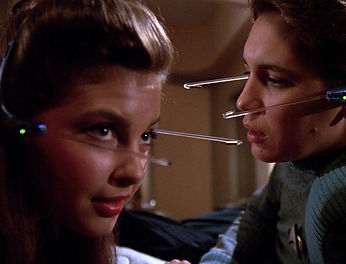
SKIPPABLE
5.7/5.8 UNIFICATION (I-II)
Spock intends to reunify Romulus and Vulcan.


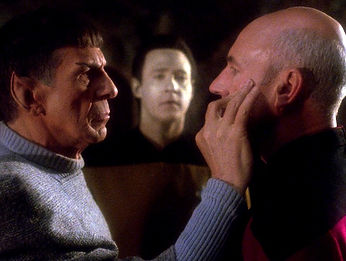
SEASON TOP 5
This is the best episode in which a regular from a previous Star Trek series guest stars on a new show. TNG has had three TOS regulars on its run -- McCoy, Spock, and Scotty -- nd of the three installments this is by far the best (DS9’s record in this regard would be quite bad, as opposed to VOY, where both Troi from TNG figured well). This evolution of Spock is completely believable and in-character: in Star Trek VI: The Undiscovered Country, released on the same year as TNG’s season 5, he similarly attempts a peace treaty with the Klingons a century before doing the same with the Romulans in this episode. Likewise, the script also succeeds in giving Spock a protagonist role instead of merely a cameo, as well as very meaningful interactions with Picard and Data. These are no small feats.
Plot-wise, this is an insightful exploration of the sociopolitical struggle internal to Romulan society. It was much needed, given that Klingons receive a lot of attention in this regard. Moreover, the writers finally get rid of the caricature of the warmongering Romulans that resemble 1980s Soviets, and introduce a fragmented and multifaceted society. Spock is the ideal character to navigate such a social landscape, and his role is very well written as the careful peacemaker and negotiator that we know and love. His relationship with Picard is also intriguing. As Picard carries Sarek within him, unsurprisingly he and Spock get off on the wrong foot, only to reconcile later... as Spock and his father never could. The episode is ripe with symbolism, culminating in the emotional final scene so beautifully acted by everyone involved.
All of this leaves relatively little room for the rest of the crew, but the secondary plot with the Enterprise hunting down a decommissioned Vulcan ship turns out to be surprisingly relevant to the main plot with the reunification. Riker has a particularly strong role, and his scenes in the night club are quite good. It’s too bad, however, that the big reveal at the end turns out to be quite ill-conceived: surely even a war-hungry Romulan commander would not be so foolish as to actually attempts a full-scale invasion of the main planet of the Federation! Sela’s plan has good dramatic effect, but politically speaking it is risible.
A historian from the future travels back in time to observe the crew.
5.9 A MATTER OF TIME
For the first half of the episode we are left wondering what it is that the time-travelling historian from the future has come to witness; i.e., how a seemingly routine mission is about to degenerate into something a lot more serious. And halfway through the episode it seems as though we get what we wished for, as the situation on the planet deteriorates. But then the script pulls a fast one by playing to what should be pretty obvious early on: that Rasmussen isn’t who he says he is. That alone doesn’t suffice to make a compelling episode, let alone a time drama. Fortunately, there is something more: the conversation between Picard and Rasmussen about a so-called "temporal Prime Directive" is wildly entertaining and intellectually stimulating, as cogent arguments are presented and analyzed carefully. But in the end that plays against the episode’s own quality, as the final reveal makes all of Picard’s worries completely useless: Rasmussen is from the past, not the future, so the Prime Directive doesn’t really apply... and we, as the audience, get the feeling that we just wasted 44 minutes. That is never pleasant. Still, Matt Frewer is a great character actor and he portrays a charismatic character, which at least makes this episode entertaining on its face -- it’s just too bad that, at the end, it is left with nothing of consequence to say.
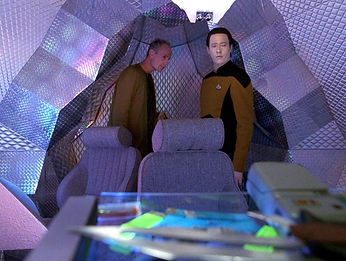
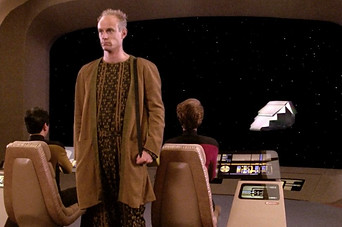
SKIPPABLE
5.10 NEW GROUND
Alexander and Worf struggle to build a father-son relationship.

SKIPPABLE
Neither plot arc (the main with Worf and Alexander and the secondary with the Soliton Wave) are very exciting on their own, and the episode is barely more than the sum of its parts. The pretext for the two arcs to eventually converge is silly, as it hinges on the audience’s attachment to Alexander’s character... which is quite a gamble! Not to mention that the radiation exposure problem is not central to the Soliton plot and is a mere contrivance. In the end, the script’s only redeeming quality is the genuine novelty of the Soliton tech, and perhaps the quasi-realistic struggle faced by father and son along the way to building a rapport. But most of it is filler, and it shows.
The sole survivor of a disaster, a child begins to emulate Data.
5.11 HERO WORSHIP
“His world is gone, Data.” An episode with a preposterous premise (a child who likes Data so much that he believes to be an android) yields a surprisingly sensitive script that takes itself seriously enough for us to care but without going overboard. The Data-Timothy relationship is more heartwarming than it has any right to be, and Spiner once more proves how good he is at walking the emotionless-emotion tightrope demanded by his character. The secondary plot with the investigation into the USS Vico disaster should be a lot more entertaining given the potential of the setting: an unexplored expanse with something scary lurking in the dark. Imagine the disappointment when that something turns out to be a subspace turbulence! How more exciting it would be if there were actually hostile aliens like the Breen, but alas. On a related note, the motivating factor to Timothy’s depression is downright silly: can an adolescent child who grew up on a starship seriously believe he caused such widespread destruction merely by touching a panel? The ending of both plots is quite underwhelming as a result, and does not adequately reward the emotional investment that the audience has been asked to put into them.
Not-so-fun fact: Gene Roddenberry (1921-1991) died during the filming of this episode. :-(
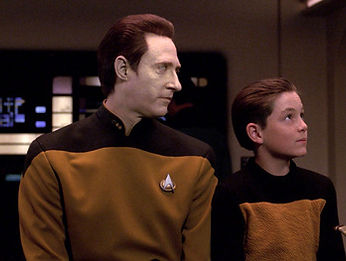

SKIPPABLE
5.12 VIOLATIONS
A number of crew members are telepathically assaulted.


SKIPPABLE
The ol’ bait and switch is really, really old in this script. At first it seems obvious that the villain is X, which means that probably it isn’t; then we are given reasons to think it’s Y, which also means that probably it isn’t; and then it turns out to have been X all along, which means that we were basically told how the episode was going to end before the main credits! But aside from the fact that the script is unable to hold our suspense for more than a few minutes, it is plagued by a criminal amount of awkwardness. The flashbacks initiated by the telepathic attacks are painfully out of character, except perhaps for Beverly’s, which is genuinely eerie. More importantly, the authors fall into the same old trap of movies and shows that portray rape as a typically predatory act performed by broody strangers (and not, as it usually is, a violent disregard of consent by an acquaintance). The combination of these factors makes the episode awkward at best and unwatchable at worst. One redeeming factor is that the Ullians’ mental capabilities are genuinely interesting -- but the best scene that features them is Keiko’s memory exploration, which again happens in the teaser, so that’s not quite good enough to tide us over for the rest of the episode. Another positive is that Troi defends herself against her assailant in the ending, without the need for a chivalrous knight-in-shining-armor role. But these good moments are too few and far between to count.
Natural disaster threatens a socially engineered colony.
5.13 THE MASTERPIECE SOCIETY
Much like S2’s “Up the Long Ladder,” this episode bites off more than it can chew, resulting in an irredeemable mess of thematic confusion. Like a freshman student’s philosophy paper, it doesn’t know exactly what it wants to be about or why. Is it supposed to warn us about the dangers of social engineering? Is it about freedom of will versus pre-determination? Is it about maintaining tradition in the face of an ever-changing world? Is it about not wanting to leave your home even when it is endangered? While the script does tackle these themes, it jumps around among them with no common thread, like a meandering and heterogeneous group discussion where a lot of people speak up but nothing gets done. I suspect that one major reason for this problem is the paucity of characters who rise above the level of self-caricatures: the charismatic leader who inevitably beds a series regular (Counselor Troi in this case), the grumpy old man who lives in the past, and the young progressive who society would hold back. It’s like watching S4’s “First Contact,” but without the thought-provoking debates. To top it all off, technobabble-of-the-week challenge is ludicrous: if the Enterprise is going to literally move a star out of its orbit, we deserve a lot more than a quick explanation of “multiphasic shifts” in the tractor beam invented by a person who until two days ago had never even seen matter-energy conversion technology.
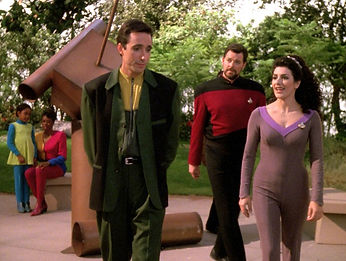

SKIPPABLE
5.14 CONUNDRUM
The crew awaken with no memory and an alien intruder in their midst.
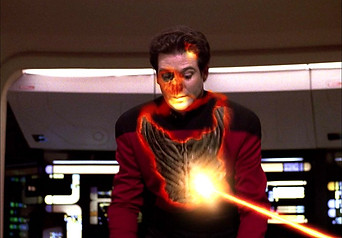

WORTH WATCHING
The premise of this episode is obviously fabricated to toss the crew into an awkward situation and allow them to rediscover themselves. This works quite well, as the script strikes just the right balance of odd and familiar to be entertaining. On the other hand, the premise really is a bit too convenient, as the crew themselves figure out about three-quarters of the way in. It is difficult for us to believe that a species whose technology is supposedly 100 years behind the Federation could rewrite humanoid minds and computers with such uncanny precision in the blink of an eye. Still, if we suspend our disbelief well enough and we buy into the background, we are rewarded with an enjoyable tale of self-discovery, garnished with a fun fly-on-the-wall effect as we know all that is wrong with the crew. In the end, of course, nothing changes, as the alien-of-the-week is defeated and the crew regain their identity. A debatable event is the random hookup between Riker and Ro, which feels forced and thoroughly out of character for both (much like the one between Beverly the Picard double in S3's "Allegiance"). It does result in a hilarious ending, however, so that too is forgivable. In the end, this is an average episode of the sort that we would expect from TNG's previous seasons..
Possessed by alien energy forms, Troi, Data, and O'Brien take over the ship.
5.15 POWER PLAY
A fun action piece with an original setting and a creative resolution. There is relatively little mystery, as we know from the get-go that the crew members are “possessed,” but that doesn’t make the action any less exciting. Hostage situations risk becoming tedious as captives inevitably come to sympathize with captors, but this script avoids all that and remains simple throughout, which plays in its favor since it has no pretense of telling a moral story. This also means that it has almost nothing to say, but it does stay true to its purpose. It’s also quite fun to see some of the show’s meekest characters (Data, Troi, and O’Brien) talk tough and shoot phasers!
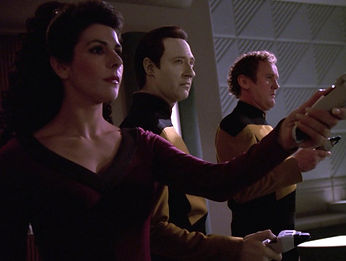
WORTH WATCHING
5.16 ETHICS
Worf considers ritual suicide after an accident leaves him paralyzed.

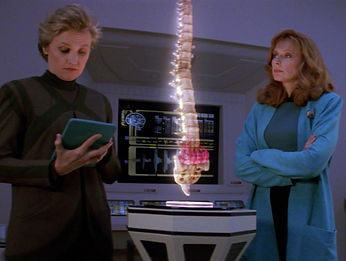
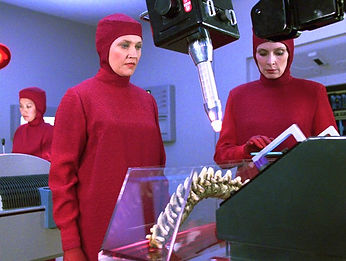
WORTH WATCHING
Few episodes like this one manage to get so much right and so much wrong at the same time. The result is a jarring viewing experience, at times completely engrossing but occasionally infuriating. First the bad news. As is expected of a TV show from the early 1990s, an episode about disability is quite ableist. There are no discussions of the fact that disabled persons may derive a significant part of their identity not only from their disability itself, but also from society’s treatment of disability as a whole. These topics are never explored, not beyond a facile appeal to the usual “disabled people can still live a fulfilling life” argument; while that’s a step in the right direction, it's not quite good enough. Another problem with the script is that it falls into a classic trap of serialized narratives: the need to get one’s hands dirty while at the same time taking the moral high ground about it. In this case, we are giving a lot of moralizing about medical experimentation from Crusher... but the fancy new surgery still fixes Worf’s disability. So we get to keep our series regular and scorn at the way in which we got to do so. VOY S5’s “Nothing Human” is basically a retelling of the same plot arc, this time with the issue of medical knowledge obtained from a concentration camp. These problems keep this episode from being thoroughly enjoyable. What’s very good about it is the personal drama. This is the best Worf-Alexander episode by far, with careful and sensitive conversations about honor, love, and father-son relationships. It is also an outstanding Worf-Riker episode, as the entire ritual suicide subplot is sensible and never overdramatic. Indeed, this might just be the most in-character that Worf is, for one would expect his reactions to be exactly what they are. The highs are indeed very high, and on an emotional and sensory level the episode works extremely well. It’s just too bad that a potentially great script would be marred by insufficient attention to -- ironically -- ethics. Remarkably, the very next episode (5.17 “The Oucast”) also presents similar issues about its treatment of gay rights, as well as a problematic metaphorical reversal.
An alien from a repressive genderless species falls in love with Riker.
5.17 THE OUTCAST
Much like the previous episode, and also like S1’s “Angel One,” this script also uses a shoddy metaphorical reversal. It tries to make a point about an injustice in the audience’s real-world society, in this case sexual discrimination, but it becomes lost in its own analogies and actually ends up supporting the opposite position. First of all, the episode embarrassingly conflates sexual traits, gender identity, and sexual attraction. Apparently in TNG’s universe all males are men and all men are attracted to women, and vice-versa. As a result, we aren’t sure what the script is actually saying --- gender shouldn’t be forced? gender roles are arbitrary? love is love is love? All is reduced to a one-size-fits-all “oppression” and the usual platitude that Soren should be free to “be herself,” which is simplistic at best and badly individualistic at worst. A more careful script would have discussed how gender is socially constructed, how attraction results from social performativity, or how advanced societies can sideline the evolutionary usefulness of biological sex. But the problem isn’t just that the episode isn’t “woke” enough: it’s also badly written. In theory, metaphorical reversals help the audience relate to the real world, but in fact they often reinforce the status quo. If we want to criticize (say) male supremacy by writing an episode about an oppressive matriarchal society, the achievement of justice in that episode will look like male empowerment. But of course the resulting script will put down women; and while the audience may be smart enough to “reverse the reversal” in their heads, what the text in fact says is that women are bad and they hold men back, an all-too-popular position of anti-feminists. The same happens in this episode, which despite its moral posturing ends up proposing a cis-normative and hetero-normative romance as “just in the face of injustice,” while in the real world it is precisely that sort of romance which is inherently oppressive. So while we can appreciate these reversals as clever and artistic turns of phrase, they are unneeded and counterproductive. If we want to tell a story about how trans* or queer folks must be free from oppression, we should make our story about precisely that, not about something else... and especially not about the exact opposite (if you’ve ever wondered why there is no alternate-universe fiction where Jews oppress Nazis, this is exactly why).
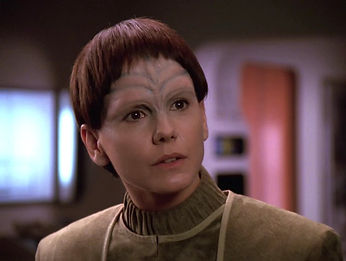
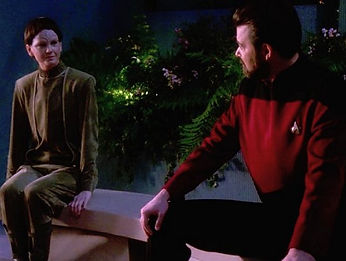
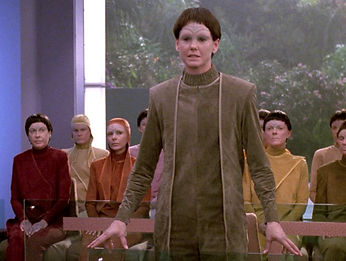
SKIPPABLE
5.18 CAUSE AND EFFECT
The ship is trapped in a repeating time loop.


WORTH WATCHING
This extremely clever story takes a relatively recent sci-fi conundrum (a la Groundhog Day) and turns into a highly entertaining mystery. The idea of watching the same story four times may seem daunting, but actually it’s a lot of fun to witness the characters figuring out more clues each time. Each realization prompted by a déjà vu is sufficiently subtle to be believable and to allow the script to build up the eeriness gradually. The actual incidents that drive the plot are carefully devised to give the audience a quantifiable way to gauge the weirdness of the feeling that the characters experience, well beyond mere reports such as “haven’t we done this before?” The poker game is especially useful in this regard. The crew figure out what's going on relatively early on, but that's quite necessary for two reasons. One, the audience needs to be invested in the mystery on a higher level than simply witnessing the oddness of repetition, and the time-loop scenario is intriguing and also believable. Two, the characters need an entire loop to figure out what message to send themselves, plus one more to receive the message and try to escape, so it was necessary to figure out the mystery in the second loop. The conclusion may be a bit silly -- of all the messages that Data could have sent, the number three seems far-fetched -- but it is exciting and it works. Fun cameo by Kelsey Grammer at the end!
Wesley's Academy flight squadron has a lethal accident.
5.19 THE FIRST DUTY
It took 25 years for Star Trek to finally set an episode on the grounds of Starfleet Academy, and boy does it deliver. Here it is shown in all its glory as every college student’s dream campus, and the setting truly does make the narrative. A fairly standard story of peer pressure is turned into a high-stakes drama on honor and morality, while at the same time eschewing an excessively jingoistic characterization of Starfleet (something which, to their credit, TNG writers were always careful to avoid). Much of the episode centers on the Picard-Wesley rapport, which is as strong as when we last left it in S4’s excellent “Final Mission.” Here Picard delivers what is perhaps his best line in the whole show: “The first duty of every Starfleet officer is to the truth, whether scientific truth or historical truth or personal truth.” The best part about this is that we can replace “Starfleet officer” with “human being” and the quote still works; nay, it works even better. Stewart’s acting goes up a notch in this episode, and further solidifies Picard’s immense gravitas -- not only as a person of principle, but as a fallible human person. Only S6’s masterpiece, “Tapestry,” would do an even better job at characterizing him. Fun fact: Robert Duncan McNeill (Tom Paris) is the third VOY regular to guest-star in TNG in a different role. The other two are Ethan Phillps (Neelix) in S3’s “Ménage à Troi” and Tim Russ in S6’s “Starship Mine.”


SEASON TOP 5
5.20 COST OF LIVING
Lwaxana tries to teach Alexander to enjoy life's simple pleasures.

SKIPPABLE
A lighthearted plot casts together two unlikely friends whose original eccentricity has been scorned in many prior episodes: Lwaxana Troi and Alexander Rozhenko. It’s an unlikely pairing, but it works, and the result is entertaining. It’s also quite soft, as the episode turns out to have little to say beyond “enjoy life and find a balance,” which surely did not require 44 minutes to say. The usual technobabble mystery in the secondary plot is both uninteresting and unrelated to the main plot, so we get the feeling that it is mere filler written to stretch the episode to its required length. So despite a few fun and funny scenes on the holodeck, as well as the iconic Lwaxana’s iconic wedding, the episode remains among the low points of the season.
Picard falls for a woman who was created as a gift to another man.
5.21 THE PERFECT MATE
TNG writers are absolutely clueless when it comes to romance, so much in fact that only S6’s “Lessons” is oustanding in that regard. This episode, instead, suffers from all the negative tropes of the genre. Attractive guest star hired for their physical attributes: check. Painfully awkward seduction scenes: check. Grossly out-of-character reactions from series regulars: check. Sexism: CHECK. The latter is especially cringe-worthy, as beneath the veneer of respectability is a trite why-don’t-women-like-nice-guys narratives; and since the “nice guy” in question is none other than Picard, it’s especially hard to watch. It’s too bad, because the basic premise of a sentient creature fabricated exclusively to bring pleasure to another would have been an excellent pretext for a discussion of rights, agency, and nature/nurture. Instead, we get one hour of “he won’t love you like I do” and “don’t leave your quarters or the miners in Ten-Forward will assault you.” Hard pass. Fun fact: this is the first major TV role for Famke Janssen, later of GoldenEye fame and of course Stewart’s co-star in the X-Men saga!
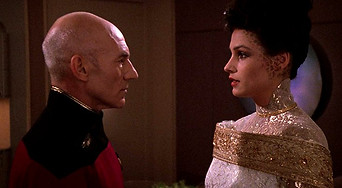
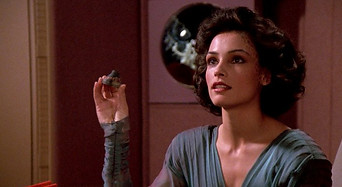
SKIPPABLE
5.22 IMAGINARY FRIEND
An alien life-form takes the shape of a child's imaginary friend.
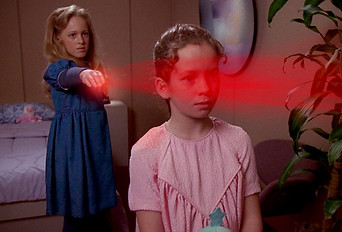
SERIES FLOP 20
Somehow, someone said in a meeting “let’s make an episode about a child with an imaginary friend, except that the friend is real and an alien”... and that person wasn’t laughed out of the room. S3’s “The Bonding” was able to make a somewhat similar premise work, but that script was set against the backdrop of intense personal drama. There is nothing of the sort here, except for painfully awkward acting and an extremely trite premise: the value of friendship is what makes us human, and any passing aliens have much to learn from us about that. Next please.
The crew rescue a Borg drone and attempt to teach it individuality.
5.23 I, BORG
This episode marks a crucial turning point in Star Trek’s treatment of the Borg. For the first time, the notion is introduced that a Borg drone may be separated from the Collective and regain their individuality. Five years later, this idea will lead to the most original character in all of Star Trek, namely VOY’s Seven of Nine. I mention all this because my (fore)knowledge of those events may tinge my lukewarm review of this episode. To put it bluntly, “I Borg” is too simplistic. The individual-collective dichotomy is always assumed but hardly explored. Through numerous conversations, Three of Five/Hugh comes to see himself as a person merely by repetition and imitation, not by argument. He sees others behaving as individuals until he too, seemingly out of the blue, refers to himself as such. But neither Crusher nor La Forge (and surely not Guinan or Picard) have argued with him from the psychological or the philosophical viewpoints. The script seems written for people who of course already know what individuals are and that of course they’re better than collectives --- but that’s not Hugh, who is given remarkably little reason to reject his programming, and yet he does anyway for the sake of drama. This is light years away from the treatment of Seven of Nine’s coming-of-age into individualism, which is extremely nuanced and much more realistic, even within the span of her very first episode (VOY S4’s “Scorpion”).
Where this episode does excel, instead, is in its ethical considerations about weaponizing Hugh. Each lead character (Geordi, Guinan, Picard) journeys from skepticism to acceptance and finally advocacy in a well written and sensible progression of beliefs. What begins with Crusher’s silly bleeding-heart attitude gradually turns into a humanitarian quest to respect the emerging personal rights of a new life-form, which after all is what TNG is supposed to be about. In this sense, the episode is just excellent. But it’s disappointing that its biggest cornerstone --- that Hugh can be an individual --- is assumed away rather than argued for.



WATCH FOR CONTINUITY
5.24 THE NEXT PHASE
Ro and La Forge are presumed dead in a transporter accident.
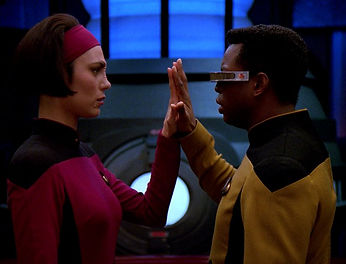

WORTH WATCHING
This is a technobabble episode, but a damn good one -- indeed, one of the best since S3's "Booby Trap." The premise is fascinating: Geordi and Ro are "de-phased" during a transporter accident, meaning that they now exist in the same space but in an ever-so-slightly different time frame from the rest of the ship. This allows them to see and hear all that happens, while they themselves are invisible and incorporeal... for the most part, anyway. The episode is inconsistent in applying this plot device, surely for the purpose of poetic license. For example, the floors are solid enough for them to walk on, but somehow the walls and other objects are not. And no explanation is given for why they sense the normal timeline but not the other way around (contrast with the two-parter "Time's Arrow," where a phase shift is more believably described as going both ways). Despite all this, the episode is highly enjoyable. The mystery is well described and carefully developed through a series of reasonable conversations. The crew's reactions to the deaths of two comrades are also balanced and sensible, if a bit too cold for what we might have expected. But the best part of the episode is how the Romulans are weaved into the story. Instead of a simple transporter accident, this one resulted from an experiment gone bad, which gives a political thriller side to the script. So while the episode has little to say in terms of depth or character development, it is very engrossing and just plain fun.
Picard experiences a lifetime on an extinct alien planet.
5.25 THE INNER LIGHT
When I assign this episode to my philosophy classes, I ask students to focus on two questions: (1) what does Picard learn about the meaning of life? (2) what is the importance of historical testimony? These are the cornerstones of an episode that was already an instant classic upon release, and which is rightfully hailed as among the best of TNG and in all of Star Trek. In my view, it argues that the meaning of life is to simply to live it, nothing else; and that the only way to truly know a person or a civilization is to share their lived lives from a first-person perspective. Most of Star Trek endorses an objectivist view of history, occasionally tinged with a hint of scientism: while tolerant, humans see themselves as the end of history, a view has led some writers to dismiss first-person narratives as “subjective” (even “feminine”) takes on history: not scientific enough, provable enough, or general enough. But this episode makes a stark 180 by embracing this minimalist tale of remembrance. Picard’s final realization (“That’s me! I’m the one it finds!”) underwrites the importance for one person to see life literally through the eyes of another in order to understand. To read or to listen is not good enough: in order to know, one must be. Many episodes in the future would pick up on this theme; VOY would go all-out, focusing not one but five distinct episodes on historical testimony as the ideal tool of cultural inquiry (S2’s "Resistance"; S3’s "Remember"; S4’s "Nemesis" and "Living Witness"; and S6’s "Memorial"). In addition to its thematic depth, one of the most memorable elements of “The Inner Light” is its music. Written by Jay Chattaway and later arranged for a full orchestra, the flute suite from this episode stands out as the only top-notch musical contribution to come out of a Star Trek epsiode. Nor is it merely decorative, but an integral component of the story (as well as of S6’s “Lessons,” which also features it prominently --- in a sense, the process of testimony isn’t complete until it is shared, which Picard does with her significant other in that episode). Overall, this is one of the most important episodes in the franchise, and perhaps the only must-watch of all of Star Trek.

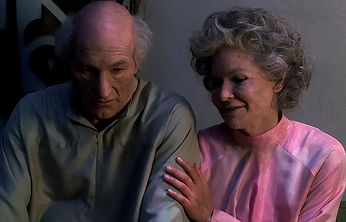

SERIES TOP 20
